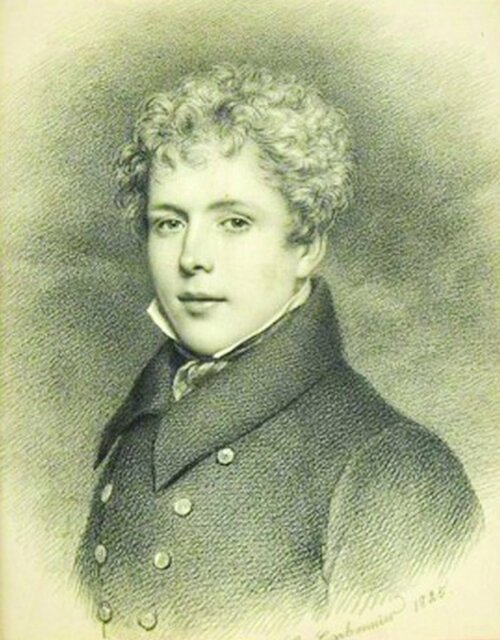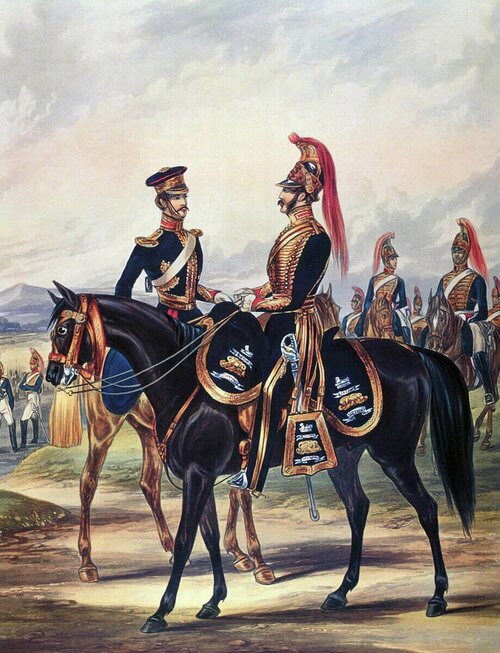Auction: 21003 - Orders, Decorations and Medals
Lot: 17
The emotive Sutlej Medal awarded to Captain J. Anderson, Bengal Artillery who, along with his elder brother William, saw significant action in India and came to the notice of senior officers on many occasions, only to be killed in the moment of victory at the Battle of Goojerat in 1849
Sutlej 1845-46, for Sobraon 1846 (Capt. J: Anderson 3rd Battn. Arty.), some slight contact marks to obverse and reverse, otherwise good very fine
Provenance:
Ex-Tamplin Collection.
Spink Numismatic Circular, June 1985.
John Anderson was born in 1807 to Alexander and Christian Anderson of London and, together with his elder brother William, both were destined for a life in the armies of the Honourable East India Company.
Entering the Bengal Artillery as a Second Lieutenant on 16 December 1824 and arriving in India later the following year, it was a full 14 years before he saw true active service: appointed Adjutant and Quarter-Master of the 1st Brigade Bengal Horse Artillery in February 1839, he was present at the Battle of Ghuznee five months later (23 July) and the subsequent occupation of Cabul. Whilst in that city he appears to have been seconded for political service, working with the Envoy at the Court of Shah Shuja-ul-Mulk. The Shah was a particularly unpleasant individual (noted for taking pleasure in mutilating his courtiers and slaves for the slightest errors) and so it must have been with some small relief that he was promoted Brevet Captain (16 December 1839) and consequently ordered back to regimental duties. Anderson next saw active service in the Sutlej Campaign, commanding No. 4 Company, 3rd Battalion at the Battle of Sobraon (10 February 1846); his battery must have been one of those which provided much-needed artillery support for the British Divisions which assaulted the hotly-contested Sikh entrenchments. It is said that when the army commander, Sir Hugh Gough, heard that artillery ammunition for the guns was running low, the old and battle-hardened veteran exclaimed: "Thank God! Then I'll be at them with the bayonet!". After several attacks Gough's army finally gained a foothold in the entrenchments and, as the Sikh army disintegrated, they withdrew across a wooden bridge spanning the river Sutlej: this lifeline with the far bank subsequently collapsed, throwing thousands of men into the tumultuous waters. The British, seeing an opportunity to inflict further casualties on their retreating foe, lined many of their guns along the riverbank and fired round after round of canister and grape shot into the Sikhs at almost point-blank range; it is highly likely Anderson was involved in this final, bloody, act of the battle. Gough therefore inflicted a severe defeat on the Sikh forces - indeed, Sobraon has been referred to as the decisive battle of the First Anglo-Sikh War.
Final Years and Journey's End
In October 1846 Anderson was appointed to command No. 4 Troop, 3rd Brigade, and led them throughout the Punjab Campaign of 1848-49; present at both the first and second sieges of Mooltan (Mentioned in Despatches by both Brigadier Markham and Major Wheler for services during the siege), in addition to the affair at Suraj-Khund, his final action was at Goojerat (21 February 1849) during which battle he met his demise.
Sources differ as to the exact nature of Anderson's death: Major-General W.S. Whish's despatch states the battery '...lost its gallant Captain, who was mortally wounded by a cannon ball' whereas the following account suggests fire from Sikh infantry was the cause:
'Two native Troops of Horse Artillery on the right were in like manner exposed to a musketry fire from the village of Kalra in their front, and suffered very severely. Captain John Anderson, a younger brother of the officer who had so distinguished himself in command of Shah Shuja's Troops of Horse Artillery during the Afghan War, was killed. No officer who fell that day was more generally lamented.' (History of the Organisation, Equipment, and War Services of the Regiment of Bengal Artillery, Maj-Gen F.W. Stubbs, refers).
Certainly whatever the case, several batteries were far forward of the line and in a most exposed position for much of the battle.
Memorial and Remembrance
Interred shortly after the battle in a small cemetery in Goojerat, it is of great interest and importance to note that Anderson's grave still survives today - the only one of six in that small space which still bears a legible inscription, reading thus:
'Beneath this tomb lie the remains of Captain John Anderson of the Bengal Artillery killed in action, on the 21st of February 1849. No man was more esteemed by the officers and men of his Regiment then he who sleeps in a soldier’s grave dug on the field of battle in the hour of victory.'
There is further record of a tablet erected in St. Stephen's Church, Dum-Dum, which reads:
'To the memory of Captain JOHN ANDERSON of the Bengal Artillery. Killed in action at Gozerat on the 21st February 1849. Erected by his brother, Major W. Anderson, CB.'
For further reading, please see: https://www.thefridaytimes.com/death-of-captain-john-anderson-bengal-artillery/
Subject to 20% VAT on Buyer’s Premium. For more information please view Terms and Conditions for Buyers.
Sold for
£850
Starting price
£320











